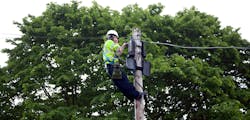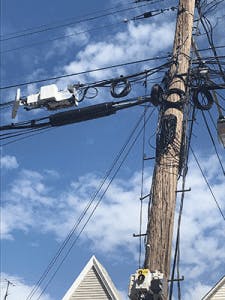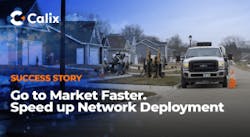Qualifying the Telecom Power Grid —
What’s that saying? What is old, has become new again. Well, when it comes to qualifying the telecom power grid, no statement could be truer. We have been hearing since the 1980s that copper was supposed to be dead by now and replaced with fiber. That couldn’t be farther from the truth.
The telecom power grid is the web of twisted-pair copper cables that run from telcom central offices or field cabinets, to almost every home or location that is not served by new fiber-to-the-home (FTTH) deployments or coaxial cable. The new greenfield deployments have never had copper but in overlay situations the copper pair still exists. These twisted-pairs provide -48 VDC — unlike the commercial power grid (also known as the electric company) that is connected to almost every site with copper wire and provides 120 VAC.
The telecom power grid uses a remote power technique that employs its own pairs to provide electricity from its central offices to power devices in the field, like digital subscriber line access multipliers (DSLAMs). This is not so with the commercial power grid. Once copper wire from the commercial power grid passes a site, it is not easy to connect.
Figure 1. One of 4 strand mounted small cells powered over existing qualified copper pairs 7,000 ft. from power source.
Getting commercial power to a small cell involves having the local power utility connect a drop wire from the upper high-voltage transformer, down the pole to a ground level service disconnect and then installing a power usage meter. This process must be repeated for each small cell, creating a time-consuming and complicated process. (See Figure 1.)
Is it possible to get commercial power where you need it? Yes.
Is it the easiest, most reliable, most cost-efficient and least time-consuming way to do it? Absolutely not.
Although AC power is available throughout North America, it is not always as accessible as we would like it to be. Think along the lines of not having an outlet in your house where you want to plug in your TV.
So, what can be done?
Necessity Is the Mother of Invention
With the ever-growing use of digital devices, including cell phones, computers, laptops, and tablets, throughout the country in cities both large and small, in sparsely populated rural towns, the need to provide reliable, economical high-speed Internet and cell service in both types of these areas, has put a spotlight on the use of the telecom copper network, which makes up the telecom power grid. As the promise of 5G comes to life, the need will only increase.
Over the years, fiber cable transmission, optical switching, network services and optical network terminals have been powered by subscriber-provided AC that converts to 12 VDC and is backed up by a UPS with a lead acid battery in the event of commercial power failure.
This non-customer-friendly method places the burden on the subscriber, requiring homeowners to sign an agreement to accept responsibility for battery maintenance. Because of this inconvenience it has become important for the telecom companies to find another source of power other than getting it through the traditional electric companies. A solution to this problem is the use of remote line power (RLP).
InvisiLight® Solution for Deploying Fiber
April 2, 2022Go to Market Faster. Speed up Network Deployment
April 2, 2022Episode 10: Fiber Optic Closure Specs Explained…
April 1, 2022Food for Thought from Our 2022 ICT Visionaries
April 1, 2022So, What Is Remote Line Power, or RLP?
RLP is the utilization of standard copper cable to power remote nodes from a centralized power source. By using the RLP, the telecom power grid is able to provide power to field devices where the electric company cannot. When the telecom uses its own pairs to provide electricity from its central offices to power devices, they use a DC-to-DC upconverter to change the -48 VDC provided by their batteries to a higher DC voltage of +/-190 VDC.
This upstream conversion is extremely efficient, with low-loss current transmitted over the twisted copper pairs. When the power reaches its destination (home or office), the process is then reversed. The cable pairs are connected to a downstream converter that transforms the power to usable 12 VDC or -48 VDC.
Remote line powering is appealing because power is being generated from a single point and can be fed to multiple small cells from that location.
It improves time-to-market by eliminating the need to coordinate with local electrical utilities for power at each small cell location, as well as it eliminates the need for AC power at each node location. This lowers capital investment.
Remote line powering also enhances network reliability and resiliency by using rectifiers, batteries, and generators, located in a centralized location.
RLP is an integral part of supplying power economically. In dense areas, to provide 5G cell phone service, cell sites have to be no more than 1,500 feet apart. It is nearly impossible to power all of this with commercial power. That is why using remote line power is so appealing to wireline and wireless carriers.
Is Remote Line Power Safe?
Figure 2. Industry line power SME demonstrates pair qualification at fixed wireless site.
It is critical to qualify the telecom power grid when planning to use remote line powering. This is the only way to know if the twisted-pair copper wires are working properly. In the telecom industry, there is an Alliance for Telecom Industry Solutions (ATIS) standard for testing twisted-pair copper wires to ensure that they can safely and effectively carry -48 VDC for normal telecom purposes, as well as ensure that they can carry +/-190 VDC (380 V).
In order to qualify the telecom power grid, several tests must be executed, including an insulation resistance test for tip to ring, as well as both tip and ring to shield. Pairs to be tested must be vacant and have no voltage on them. They are then tested for both AC and DC voltage. These tests can be performed safely, reliably and easily by using an insulation resistance tester, like the Megger testers that offer a 500 V test threshold, which is higher than the 380 V threshold being used to power the telecom power grid. Most industry standard multifunction test sets test up to only 150 V and therefore can pass a suspect pair with thin insulation or a faulty or corroded connector. The 500 V stresses the pair and connection to ensure pair integrity. (See Figure 2.)
If the pair being tested passes each of the tests, it is guaranteed that the pair can safely and consistently carry the +/-190 VDC necessary to remotely power the telco device. If the pair fails these tests, the test sets allow the technician to determine the cause and location of the failure. These testing units can be used to qualify cable for powering DSLAMs, cables for powering FTTH and the Internet of Things (IoT), as well as powering small cell radios and fixed wireless.
Telecom Power for the Future
As we continue to move forward, IoT will require millions of devices in places that are all but impossible to power, both physically and economically, with commercial power. These devices will need to be powered remotely over new or existing twisted-pair copper which will have to be qualified first.
No matter how you look at it, qualifying the telecom power grid is not only beneficial it is also essential. The telecom power grid is the most economical and reliable means to get power to remote areas or to those areas that are densely populated and overrun with users and the new demand for electrical connections. Qualifying the power grid gives peace of mind to all who will use it.
For more information, please email [email protected] or visit https://us.megger.com.
Follow Megger on Twitter @meggerUSA.
Like this Article?
Subscribe to ISE magazine and start receiving your FREE monthly copy today!
About the Author







